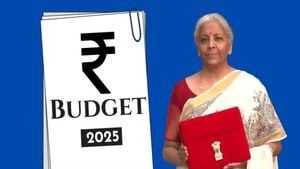Vietnam's economy is on the cusp of significant change as 2025 approaches, particularly driven by recent consumer trends reflective of the shifting economic climate. According to various market forecasts, there is mounting evidence to suggest Vietnamese consumers are increasingly turning to second-hand goods as their shopping preference, driven largely by rising economic pressures and the need for cost-saving strategies.
The second-hand goods market, currently projected to reach a staggering $5.1 billion by 2026, reflects not only the alteration of shopping habits but also indicates resilience among consumers searching for affordability. “During the end of the year, especially when the economy shows signs of slowing, consumers tend to prioritize spending-saving shopping solutions, and cheap used goods become the ideal choice,” stated Nguyễn Thiên Ca, the Product Development Manager at Chợ Tốt, one of Vietnam's leading online marketplaces.
GlobalData’s survey revealed insights indicating 41% of respondents considered second-hand items before committing to new purchases, with the trend even more pronounced among younger generations, including 62% of Generation Z and Millennials. Such statistics illuminate the wider shift toward sustainable consumption patterns, as many Vietnamese consumers are growing aware of the environmental impacts associated with wasteful consumerism.
Alongside the increased interest in second-hand products, recent reports indicate significant fluctuations within the used car market. Following the boom of interest earlier last year, January 2025 has seen this market drop by as much as 67%, markedly reflecting both declining supplies and diminished consumer demand due to economic hesitancy. Factors such as extended Tet holiday periods traditionally suppress major transactional activity, leading to this notable slowdown.
On the travel front, Vietnam's tourism dynamics also present compelling narratives. During the upcoming Tet holiday, domestic travel is projected to be extraordinarily popular, with 94% of Vietnamese travelers expressing a desire to explore their own country. Meanwhile, mind-boggling figures reflect international preferences, as the average expense for domestic travel rests around 13.89 million VND compared to 36.95 million VND for outbound journeys, showcasing the willingness of Vietnamese to splurge more on international experiences.
The Outbox Company compiled insightful findings outlining popular domestic destinations during the Tet celebrations, with Đà Nẵng, Hà Giang, and Hà Nội among the leading choices. The actual benefits of local travel include ease of planning and the opportunity for unique cultural interactions, which consumers seem eager to embrace, particularly as they travel with family or loved ones during this important holiday season.
The variance in travel spending—higher for international trips than domestic tours—reflects underlying trends related to preparation and values placed on travel experiences. The prospect of detailed planning for international trips results in higher spending to tackle visa requirements and travel expectations.
These economic trends and forecasts leading up to 2025 highlight the nuanced behavioral shifts among consumers, driven both by necessity and heightened interest in sustainable practices. Business leaders and market analysts alike will need to carefully navigate this terrain where consumer choices reflect broader socio-economic patterns shifting significantly across the Vietnamese consumer base.
With both the used goods market and tourism sector grappling with rapid developments and changing consumer behavior, the upcoming years will undoubtedly usher new strategies for retailers and service providers. The challenge lies not only in adapting to current market conditions but also embracing these changes as opportunities for growth and creativity within Vietnam's economy.



